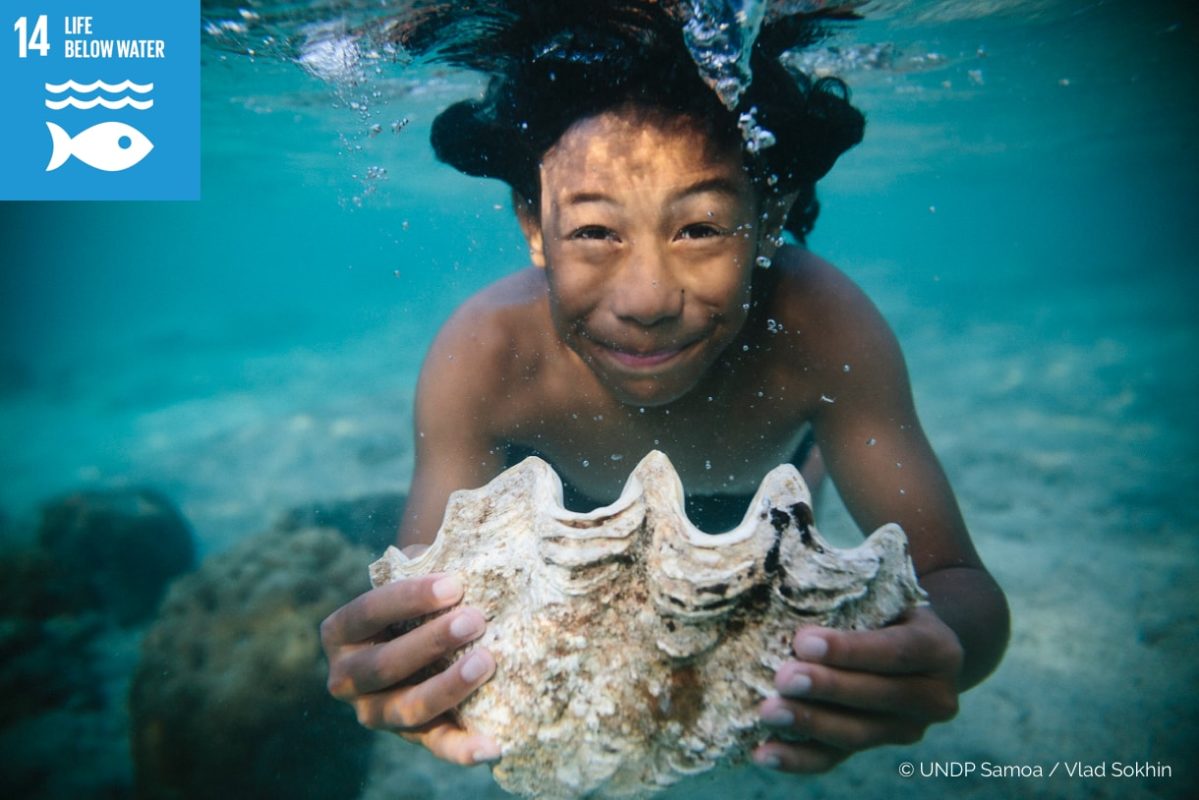United Nations Sustainability goal 14 looks at life below the water (1).
The UN goals says…
“Marine pollution, an overwhelming majority of which comes from land-based sources, is reaching alarming levels, with an average of 13,000 pieces of plastic litter to be found on every square kilometre of ocean.
The SDGs aim to sustainably manage and protect marine and coastal ecosystems from pollution, as well as address the impacts of ocean acidification. Enhancing conservation and the sustainable use of ocean-based resources through international law will also help mitigate some of the challenges facing our oceans.”
Plastic Polution
Since the broadcast of Blue Planet II almost everyone in the UK and farther afield have become aware of the huge problem of plastic in our oceans. It’s not only the huge plastic islands floating in the ocean, or the fishing nets and debris entangling sea creatures, it’s the hard to see micro-plastics. These don’t just come from cosmetics, larger items such as polyethylene plastic bags will eventually break down into micro-plastics.
“We haven’t found one sample from around the world anywhere that doesn’t have at least one piece of micro-plastic in it” – Professor Tamara Galloway – University of Exeter (2)
As much as 8 million tonnes of plastic is entering the oceans every year. That’s a rubbish truck a minute dumped into the ocean somewhere in the world. The micro-plastics overlap with the food prey of many marine animals, particularly those at the base of the food web including copepods, worms and bivalve mussels.
In research done by the University of Exeter every single mussel tested had digested micro-plastics. Organisms from the size of zooplankton to larger species in the food chain contain micro-plastic creating bio-magnification where a plankton may eat just a few grains of micro-plastic, a whale may potentially be consuming many tonnes!
So it’s quite clear that Plastics in the ocean is a huge problem.
But surely in the UK our plastic isn’t entering the ocean?
“there are many other sources of plastics that will eventually end up in the oceans. 10% of what we use will eventually make its way to the oceans, by blowing off landfill sites, making its way down waterways. So simply reducing how much plastic you use in your everyday life would make a big impact into what’s getting into the oceans.” Dr Ceri Lewis – University of Exeter
So What about Plastic recycling?
So you might think that in the UK we recycle much of our plastic and deal with it in a responsible way. Well sadly that’s not the case. I have contacted several commercial waste contractor with mixed cardboard and plastics recycling in the same way that domestic households in the county do.
The contractor collects the waste where they put it onto a conveyor belt, and through a mixture of hand sorting and optical detection sort the plastic into different types as well as cardboard.
The plastic and cardboard are then bundled up and sold on the commodity market based on the current market price to whoever wants to buy and recycle them.
The lack of investment in recycling and re-processing infrastructure, waste-to-energy facilities and policy incentives means the UK currently exports two thirds of plastic waste to other countries – 4.15m metric tonnes over the past seven years (3).
Two thirds of our Plastic Waste is exported for other countries to deal with, absolutely shocking!
There is a hidden factor to this export. Perhaps surprisingly international shipping doesn’t fall under the Paris Climate accord for greenhouse gas emissions accounting for 2.2% of emissions worldwide.
It has been publicised that China is refusing to take UK plastic exports due to the poor quality. Perhaps what is not so widely publicised is that it is being shipped to countries such as Vietnam, Poland, Thailand and Malaysia.
It seems we are sweeping our poor quality waste under someone else’s carpet!
Even with a rapid change in government policy it will take years before sufficient recycling plants are built in the UK. If other countries follow China’s lead we may have nowhere to recycle our plastic!
Two thirds of UK Plastic Waste is exported
Plastic waste being sorted by hand in Babakan, West Java, Indonesia. Image source the Ecologist.
“there remains concern that some shipments of material are being mis-described as being on the greenlist, when they are actually illegal shipments of mixed municipal waste disguised with thin layers of light recyclables such as paper or plastic.”
Ecologist article
How does this relate to climate change?
Perhaps surprisingly this rise in ocean plastic pollution is closely related to climate change.
“Reducing pollution impacts on the oceans is important in creating resilience and adaptive capacity for marine species. We need clean habitats for the climate-driven mass-migration that is about to occur in our oceans. There is also new research suggesting that the consumption of microscopic plastic debris by tiny animals in the ocean could weaken the ocean carbon sink.” – University of Exeter
What can be done about plastic?
It is possible to remove plastic from packaging for many products.
We must look at packaging supply chains, with the aim of making packaging locally in the UK. This reduces transport distance and the carbon footprint, but also allows us to better understand the source of board materials and to know that they are sustainably managed.
For example board from James Cropper papers in the Lake District. Their board in turn is certified to FSC® (Forest Stewardship Council®) and separately to PEFC (Programme for the Endorsement of Forest Certification) standards. Both certifications require an auditable chain of custody for pulp sourced by the mill. All the pulp purchased is manufactured using either an Elemental Chlorine Free (ECF) or a Totally Chlorine Free (TCF) bleaching process. Their electricity is part generated by hydro-electric at the mill.
Cardboard is much more widely recycled in the UK.
Home compostable materials
These can be used as an alternative where a clear solution or a food contact safe barrier that can’t be achieved with card is required. Home compostable materials can be made from wood pulp. Natureflex is an example of such a material.
This starts to create a circular economy.
The plants are grown on certified sustainable forestry plantations. As they grow they absorb CO2. They are turned into food contact safe packaging. After the packaging is used it can either be home composted, putting nutrients back in the soil, or used in biomass electricity generation with a carbon sink – the carbon sink part is important.
CIRCULAR ECONOMY
“Today, nearly everybody anywhere comes into contact with plastics, especially plastic packaging. Unfortunately, after a short first use cycle, 95% of plastic packaging material is lost to the economy. That’s 80 to 100 billion US dollars. 32% of plastic packaging escapes collection systems and ends up in our oceans or landfills or just littering the streets. So using less is one thing, but we need more solutions. Multiple research efforts and some best practise examples have showed that a transition towards a more circular economy can bring about the lasting benefits of more innovative, resilient, and a productive economy.
Potato Peelings
A further example of a circular usage is the use of inflatable cushions made of potato peelings for courier shipping.
The aim is to first reduce the size of shipping packaging.
However sometimes cushioning is required and that’s where potato peelings come in to play.
Potatoes are grown and absorb CO2. As a waste product of the potato industry potato peelings are taken and turned into inflatable air cushions. The air cushions are used to ship our products. They are then home composted returning to the soil, or used in biomass electricity generation.
It makes long-term business and environmental sense to transition from our current take and make waste linear economy to a more circular one that views waste as technical nutrients,” – Sandra Lee – Sustainability Manager University of Leicester
In a subsequent post we’ll look at Ocean acidification, why it’s happening and how we can help.
(1) UN Sustainability Goal 14 – Life below Water
(2) Professor Tamara Galloway – University of Exeter https://youtu.be/veMdowmPSbw
(3) Packaging News, packaging industry magazine March 2019


